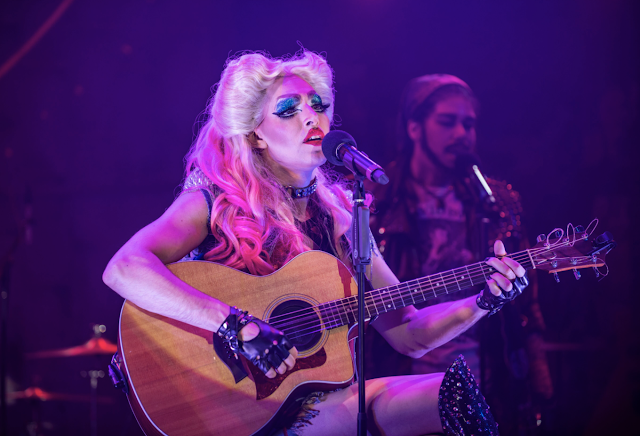Milwaukee Opera Theatre & Danceworks Make Magic Once Again
As a seasoned fan of the Milwaukee Opera Theatre (MOT), there’s something I’ve noticed over the years: This company is at their very best and brightest whenever they partner with Danceworks Inc. With MOT under the direction of Jill Anna Ponasik and Danceworks under the artistic direction of Christal Wagner, it’s a match made in — well — this time it’s a Slavic river teeming with nymphs and sprites. That’s where the latest MOT + Danceworks collab, Rusalka, takes place. I was lucky to see this magical show on opening night at Danceworks Studio. I enjoyed it so much, I made the mistake of telling others to rush out and see it, only to learn this one-weekend run is all but sold out. But perhaps, if we clamor loudly enough, the run could be extended… A fangirl can hope. To do my part in loudly clamoring, read on for 5 reasons this Rusalka is so bewitching and derves to run for weeks and weeks. Oh the whimsy! The humor! This is the MOT + Danceworks sweet spot. These two companies always bring out the best in each other, and Rusalka is no exception. There’s a fantastical, fairytale quality to this story that makes for an enchanting spectacle for eye and ear. In fact, many unfamiliar with the myth of Rusalka might be quick to say, “Ahhh… it’s like The Little Mermaid!” And they’d be right. Rusalka is a water nymph who falls in love with a human and trades her voice to a witch for the chance to join her prince on land. But this isn’t Disney, so there’s no “Kiss the Girl” and (unsurprising spoiler) no happy ending. MOT’s Rusalka has been adapted wonderfully by Jason Powell, so it has been trimmed of its original three-hour length to something today’s audiences can tolerate. While the singing is in Czech, spoken English interludes move the story along and do so in pleasant, ultra-charming rhyme. This Rusalka is immensely funny, fanciful, lighthearted, all-around delightful, and had me thinking: “This is so Milwaukee Opera Theatre.” The voices! The music! Rusalka opens with a Wood Nympth Trio (Tabetha Steege, Erin Sura, Brennan Martinez) who are each and in harmony as lovely as can be. Next we are treated to Rusalka’s “Song to the Moon.” Saira Frank plays the titular role and she and her voice are, in a word, ravishing. Frank is a master of that starry-eyed, dreamy sensibility of an amorous river nymph. Then there’s Ježibaba (Colleen Brooks) the evil sorceress who grant’s Rusalka’s wish. Brooks’ mocking way makes for delicious witchiness. Next we meet the Prince (Tim Rebers) whose comedic delivery makes way for strong, strapping vocals. Rebers and Brooks share captivating chemistry and intimacy, particularly in their final tragic duet. Lastly, as Rusalka’s father Vodník, David Guzmán beautifully bellows his “Lament.” All of the singing is supported by a simple musical duet: a piano (Ruben Piirainen) and a harp (Erin Brooker-Miller). While the piano grounds, the harp brings splendid magic, proving that for this Rusalka, that’s all you need. The dancing! The movement! There are eight Danceworks dancers in Rusalka, filling the cozy stage with big energy. Throughout the show, the dancers take on myriad roles: sprites doing sprightly things, demons doing demonic things. The dances range from fluid to frenzied, darkly writhing to tenderly rolling. The dancers’ all-around agility and emotive movements help set the mood and the scene, giving the audience something marvelous to look at when the operatic words are lost on you. One of my favorite dances occurs during a party given by the Prince. With red solo cups as props and a Foreign Princess getting progressively tipsy, it’s all so amusing and imaginative, good luck not grinning widely. The looks! Inspired! The costumes, hair, and makeup for Rusalka are not to be passed over in praise. Together, they set the tone and transport the audience to various worlds. The mystical sprites and nymphs don their best Ren Faire garb: flowy frocks in earth or water tones, trimmed with ribbons and the occasional sparkle of sequins. In stark laugh-aloud contrast, the very human Prince appears to have emerged from the pages of a J.Crew catalog. A final fashion shout-out to Vodník’s fully-painted bald head and beard. That’s dedication, and it pays off in creating an otherworldly vibe. The Moon! Aka Jason Powell! Saving one of the best for last, Jason Powell as our narrator, The Moon, tops my list of Rusalka favorites. First, thank-you to Powell for adapting this opera into something we mere mortals can contend with. Second, Powell’s easygoing good humor may just make his Moon one of the most-likable characters I’ve seen on stage this season. His costume: A white mechanic’s jumpsuit with MOON scrawled on the pocket, polished off with gold sequined kicks. Powell easily earns his showstopper “Glorification of the Moon,” despite admitting: “Does it move the plot? It categorically does not.” Placed just before the final tragic duet of the show, this ode to The Moon clinches it: Rusalka will leave you utterly enamored with every inch of the spectacle before you. Visit milwaukeeoperatheatre.org and danceworksmke.org to see what's next for these gems of Milwaukee's performing arts scene.






